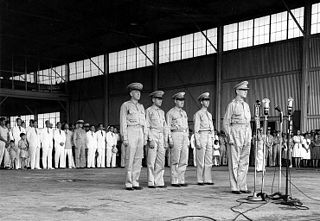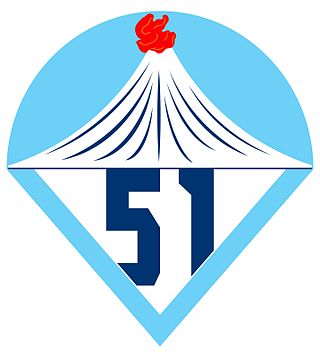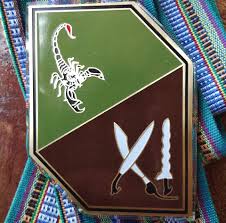
United States Army Forces in the Far East (USAFFE) was a military formation of the United States Army active from 1941 to 1946. The new command's headquarters was created on 26 July 1941, at No. 1, Calle Victoria, Manila, Luzon, the Philippines, with General Douglas MacArthur as commander. The Chief of Staff was Brigadier General Richard K. Sutherland and the Deputy Chief of Staff was Lieutenant Colonel Richard J. Marshall. The core of this command was drawn from the Office of the Military Advisor to the Commonwealth Government of the Philippines.

The 2nd Infantry Division, Philippine Army nicknamed Jungle Fighter, is the Philippine Army's primary infantry unit specializing in jungle warfare.

The Western Mindanao Command is the Armed Forces of the Philippines' unified command in charge of the Zamboanga Peninsula, Northern Mindanao, and the BARMM. It is responsible for the defense of these areas against external aggression, as well as combating terrorism and insurgency. It is also one of the government organizations advocating the "Culture of Peace" in Mindanao.

The 8th Infantry Division, Philippine Army, known officially as the Storm Trooper Division, is one of the Philippine Army's Infantry units in the Visayas and under the AFP Central Command, combating local communist insurgent units, and terrorists.
The 104th Infantry Brigade, 1st Infantry Division, Philippine Army, known officially as the Sultan Brigade, is one of the brigades of the Philippine Army which is organic to its 1st Infantry Division. It is an infantry unit, and specializes in anti-guerrilla warfare.

The 41st Infantry Division was a division of the Philippine Army under the United States Army Forces in the Far East (USAFFE).

The 61st Division of the Philippine Army was an infantry division from the 1930s to 1942.

The 51st Infantry Division was a division of the Philippine Army under the United States Army Forces in the Far East (USAFFE).

The 31st Infantry Division was a division of the Philippine Army under the United States Army Forces in the Far East (USAFFE).

The 21st Infantry Division was one of the 10 reserve division of the Philippine Army mobilized under the United States Army Forces in the Far East (USAFFE). The unit was involved in the delaying action against the Japanese invasion in the plains of Central Luzon, and the Battle of Bataan in 1942.

The 11th Infantry Division was one the reserve division of the Philippine Army that was mobilized in September 1941 under the United States Army Forces in the Far East (USAFFE).

The 71st Infantry Division was a division of the Philippine Army under the United States Army Forces in the Far East (USAFFE).

The 81st Infantry Division was a reserve division of the Philippine Army under the United States Army Forces in the Far East (USAFFE). It was established in the prewar period and fought 1941-1942.

The 101st Infantry Division was one the reserve divisions of the Philippine Army under the United States Army Forces in the Far East (USAFFE).

The 91st Infantry Division was a division of the Philippine Army under the United States Army Forces in the Far East (USAFFE).

The 11th Infantry Division, Philippine Army, also called the Alakdan Division, is one of the Philippine Army's infantry units in Mindanao. Currently still forming, the Division is expected to complete its equipment and manpower requirements by 2022. It is the youngest of all the infantry divisions of the Army and will have 4,500 troops when fully formed.
The North Luzon Force was a corps-sized grouping of the U.S.-sponsored Philippine Army, defeated in battle against the Japanese in 1941–42.
Luzon Force or Bataan Defense Force is a short-lived Field Army size unit created in the Philippines after the restructure of command organized by General Douglas MacArthur commander of US Army Forces in the Far East (USAFFE). He wished to control the 4 Commands from Australia with its representative in Corregidor Island. Major General Jonathan M. Wainwright IV was selected to command as the senior general officer in Bataan peninsula.
South Luzon Force was a corps-sized unit of the US Army Forces Far East (USAFFE) active in the Philippines between 1941 and 1942. Created along with other 3 commands under the USAFFE, it was officially announced on November 4, 1941, and BGen. George S. Parker was appointed to command, making him responsible for the defense of Southern Luzon of any invasion. General Parker established his headquarters in Fort William McKinley in Rizal province.
United States Forces in the Philippines (USFIP) was created due to the confusion caused by General Douglas MacArthur's departure to Australia. Based on this reorganization, forces in Bataan will be under new command Luzon Force under MGen. Jonathan M. Wainwright as the senior general officer in Bataan, the Visayan-Mindanao Force under MGen. Sharp will be split to Visayan Force under BGen. Bradford Chynoweth, Mindanao Force under MGen. William F. Sharp, and Harbor Defenses of Manila and Subic Bays under MGen. George Moore will independent from each other and will directly report to General MacArthur's USAFFE headquarters in Australia through his representative Col. Lewis Beebe formerly his G4 in Corregidor; he promoted Col. Beebe to BGen and made him Deputy Chief of Staff, USAFFE. US War Department in Washington has started addressing MGen. Wainwright as CG, USFIP as General MacArthur still needs to inform Washington of the new structure. The War Department, through General George C. Marshall, found the structure unsatisfactory and anticipating the Philippines would soon be isolated. In the end, it decided to have one commander in the Philippines, BGen. Lewis Beebe followed the directive from Washington, D.C., and turnover the correspondence to Wainwright.


















